DistMesh
来源:互联网 发布:ubuntu server配置 编辑:程序博客网 时间:2024/06/14 01:12
DistMesh - A Simple Mesh Generator in MATLAB
News (Mar 11, 2012)
I have not been maintaining/updating the distmesh code since I wrote it, butby popular request I have now posted a new version. The main differences andnew features are:- New 3-D surface mesh generator distmeshsurface.m, type "help distmeshsurface" to see some examples.
- Support for general implicit functions in distmesh2d and distmeshsurface. This means e.g. that an ellipse can be represented by the simple expression phi(x,y)=(x/a)^2+(y/b)^2-1, even if this is not a signed distance function.
- Robustness improvements in distmesh2d, including removal of duplicated fix points, density control, and a final mesh cleanup.
- Recompiled C-functions for 32/64-bit Windows, 64-bit Mac OS X, and 64-bit linux.
- More examples and more consistent size functions in the examples, including a NACA0012 airfoil mesh. Type "help distmesh2d", run the demo "meshdemo2d", or just look at the examples further down on this page.
Description
DistMesh is a simple MATLAB code for generation of unstructuredtriangular and tetrahedral meshes. It was developed byPer-Olof Persson (nowatUC Berkeley) and Gilbert Strang in the Department of Mathematics atMIT. A detailed description of theprogram is provided in our SIAM Review paper, see documentation below.
One reason that the code is short and simple is that the geometries arespecified bySigned Distance Functions. These give the shortestdistance from any point in space to the boundary of the domain. The signis negative inside the region and positive outside. A simple example isthe unit circle in 2-D, which has the distance functiond=r-1,where r is the distance from the origin. For more complicatedgeometries the distance function can be computed by interpolation betweenvalues on a grid, a common representation for level set methods.
For the actual mesh generation, DistMesh uses the Delaunay triangulationroutine in MATLAB and tries to optimize the node locations by a force-basedsmoothing procedure. The topology is regularly updated by Delaunay.The boundary points are only allowed to move tangentially to the boundaryby projections using the distance function.This iterative procedure typically results in very well-shaped meshes.
Our aim with this code is simplicity, so that everyone canunderstand the code and modify it according to their needs. The codeis not entirely robust (that is, it might not terminate and return awell-shaped mesh), and it is relatively slow. However, our currentresearch shows that these issues can be resolved in an optimized C++code, and we believe our simple MATLAB code is important fordemonstration of the underlying principles.
To use the code, simply download it from below and run it from MATLAB.For a quick demonstration, type "meshdemo2d" or "meshdemond".For more details see the documentation.
Download
Download the archive below and unpack. Add this directory to your MATLABpath, or make it the current directory. The code contains some C++ files,and binaries for 32/64-bit Windows, 64-bit Mac OS X, and 64-bit linux areprovided, as well as the source code.
- distmesh.zip Current version 1.1 - complete package (ZIP archive)
- distmesh_v10.zip Original version 1.0 - complete package (ZIP archive)
DistMesh is distributed under the GNU GPL;see the License and Copyright notice for more information.
Documentation
- P.-O. Persson, G. Strang, A Simple Mesh Generator in MATLAB.
SIAM Review, Volume 46 (2), pp. 329-345, June 2004 (PDF) - P.-O. Persson, Mesh Generation for Implicit Geometries.
Ph.D. thesis, Department of Mathematics, MIT, Dec 2004 (PDF) - Function reference
Gallery
- Images
- Movies
- Interactive Java Applets
- Applications and Moving Meshes
Examples
% Example: (Uniform Mesh on Unit Circle) fd=@(p) sqrt(sum(p.^2,2))-1; [p,t]=distmesh2d(fd,@huniform,0.2,[-1,-1;1,1],[]);
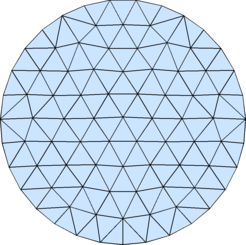
% Example: (Rectangle with circular hole, refined at circle boundary) fd=@(p) ddiff(drectangle(p,-1,1,-1,1),dcircle(p,0,0,0.5)); fh=@(p) 0.05+0.3*dcircle(p,0,0,0.5); [p,t]=distmesh2d(fd,fh,0.05,[-1,-1;1,1],[-1,-1;-1,1;1,-1;1,1]);
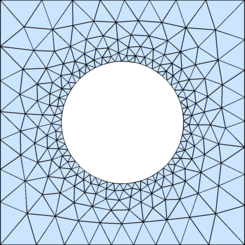
% Example: (Polygon) pv=[-0.4 -0.5;0.4 -0.2;0.4 -0.7;1.5 -0.4;0.9 0.1; 1.6 0.8;0.5 0.5;0.2 1;0.1 0.4;-0.7 0.7;-0.4 -0.5]; [p,t]=distmesh2d(@dpoly,@huniform,0.1,[-1,-1; 2,1],pv,pv);
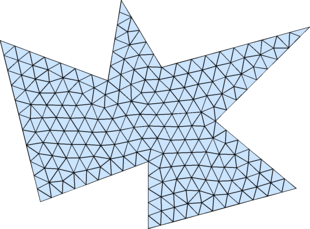
% Example: (Ellipse) fd=@(p) p(:,1).^2/2^2+p(:,2).^2/1^2-1; [p,t]=distmesh2d(fd,@huniform,0.2,[-2,-1;2,1],[]);
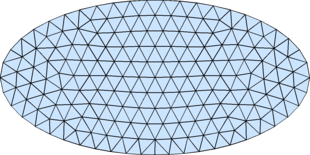
% Example: (Square, with size function point and line sources) fd=@(p) drectangle(p,0,1,0,1); fh=@(p) min(min(0.01+0.3*abs(dcircle(p,0,0,0)), ... 0.025+0.3*abs(dpoly(p,[0.3,0.7; 0.7,0.5]))),0.15); [p,t]=distmesh2d(fd,fh,0.01,[0,0;1,1],[0,0;1,0;0,1;1,1]);
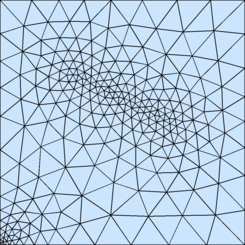
% Example: (NACA0012 airfoil) hlead=0.01; htrail=0.04; hmax=2; circx=2; circr=4; a=.12/.2*[0.2969,-0.1260,-0.3516,0.2843,-0.1036]; fd=@(p) ddiff(dcircle(p,circx,0,circr),(abs(p(:,2))-polyval([a(5:-1:2),0],p(:,1))).^2-a(1)^2*p(:,1)); fh=@(p) min(min(hlead+0.3*dcircle(p,0,0,0),htrail+0.3*dcircle(p,1,0,0)),hmax); fixx=1-htrail*cumsum(1.3.^(0:4)'); fixy=a(1)*sqrt(fixx)+polyval([a(5:-1:2),0],fixx); fix=[[circx+[-1,1,0,0]*circr; 0,0,circr*[-1,1]]'; 0,0; 1,0; fixx,fixy; fixx,-fixy]; box=[circx-circr,-circr; circx+circr,circr]; h0=min([hlead,htrail,hmax]); [p,t]=distmesh2d(fd,fh,h0,box,fix);
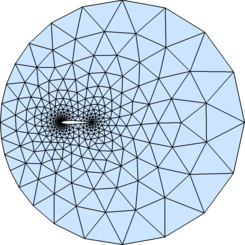
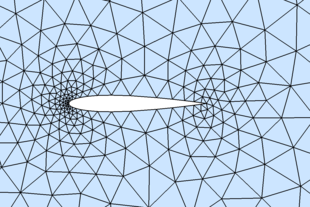
% Example: (Uniform Mesh on Unit Sphere) fd=@(p) dsphere(p,0,0,0,1); [p,t]=distmeshsurface(fd,@huniform,0.2,1.1*[-1,-1,-1;1,1,1]);
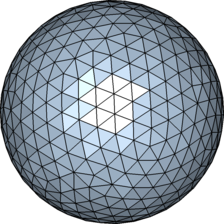
% Example: (Graded Mesh on Unit Sphere) fd=@(p) dsphere(p,0,0,0,1); fh=@(p) 0.05+0.5*dsphere(p,0,0,1,0); [p,t]=distmeshsurface(fd,fh,0.15,1.1*[-1,-1,-1;1,1,1]);
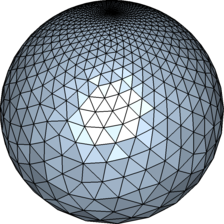
% Example: (Uniform Mesh on Torus) fd=@(p) (sum(p.^2,2)+.8^2-.2^2).^2-4*.8^2*(p(:,1).^2+p(:,2).^2); [p,t]=distmeshsurface(fd,@huniform,0.1,[-1.1,-1.1,-.25;1.1,1.1,.25]);
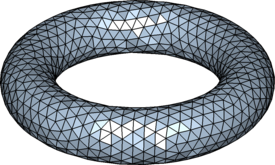
% Example: (Uniform Mesh on Ellipsoid) fd=@(p) p(:,1).^2/4+p(:,2).^2/1+p(:,3).^2/1.5^2-1; [p,t]=distmeshsurface(fd,@huniform,0.2,[-2.1,-1.1,-1.6; 2.1,1.1,1.6]);
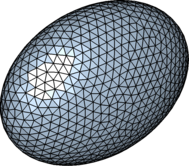
Per-Olof Persson
Department of Mathematics, UC Berkeley
persson@berkeley.edu
- DistMesh
- distmesh划分网格之正方形内含椭圆
- Matlab网格划分程序Distmesh讲解(一)
- touchstart,touchmove判断手机中滑屏方向
- 提高 service 存活率
- SEI各种语法以及SEI消息在解码、显示或其它过程中起辅助作用
- HBase 创建表预分区
- java中正则匹配的贪婪模式和非贪婪模式
- DistMesh
- Android studio编译报错:Error:Execution failed for task ':app:transformClassesWithDexForDebug'
- 121Best Time to Buy and Sell Stock
- 支持向量机(SVM):基本原理
- 树莓派3B ssh登录 密码无限错误
- redis主从复制
- MPAndroidChart之LinChart(3)scale缩放
- IPC-命名管道(FIFO)
- Android 之 内存管理


